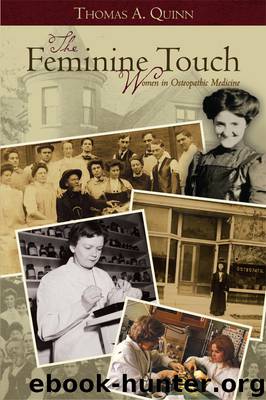The Feminine Touch: Women in Osteopathic Medicine by Thomas A. Quinn

Author:Thomas A. Quinn [Thomas A. Quinn]
Language: eng
Format: epub
Tags: MEDICAL/History; MEDICAL/Alternative Medicine
Publisher: Truman State University Press
Published: 2012-07-08T16:00:00+00:00
Chapter Five
The Modern Era of Osteopathic Medicine, 1965 to Present
“The most any physician can do for a patient is to render operative the forces within the body itself.”
Andrew Taylor Still, MD, DO
“The feet of women are marching towards medicine, and there’s no way we cannot break through doors—just because of sheer numbers.”
Geraldine T. O’Shea, DO
IN 1964, THE FIVE REMAINING OSTEOPATHIC MEDICAL SCHOOLS graduated only four female DOs, a meager 1.1 percent of the combined graduating class of all five schools. In that year, there were only twenty-three women enrolled in the osteopathic medical schools, representing only 1.8 percent of the combined student body. The osteopathic profession started to recover its female enrollment rate beginning in 1965, two years before the allopathic female enrollment rate began to recover.1 Thus 1965 can be seen as the beginning of the modern era for women in osteopathic medicine.
In 1969, the colleges of osteopathic medicine had a combined female student enrollment rate of 3 percent, and female enrollment continued to increase in the succeeding years. However, during this same period, the number of women entering allopathic medical schools increased even more. In 1969, the MD schools had a 9 percent female enrollment rate and by 1993 40.2 percent of all students enrolling were women. This is the only period when allopathic schools had a higher percentage of women enrolling than osteopathic schools. By 1988, the MD schools already had an enrollment of 35 percent women, and it took the DO schools five years to catch up. The exact reason for this discrepancy in female enrollment remains unclear, but it appears that there were not as many female applicants to the osteopathic schools. In October 1995, the Journal of the American Osteopathic Association printed an article calling for the recruiting of more female applicants to osteopathic colleges.2
Percentage of female students in osteopathic medical colleges
1973 = 6.5
1978 = 16.3
1980 = 19.7
1985 = 27.7
1990 = 32.7
1995 = 36.3
2000 = 41.1
2005 = 49.6
2007 = 50.0
SOURCE: AOA, Osteopathic Medical Profession Report, 2008, 7–8.
Nearly fifty years had passed since the A. T. Still College of Osteopathy and Surgery opened in 1922 and merged with the American School of Osteopathy two years later. That was the last new osteopathic college for a long time. In the years between, osteopathic colleges either closed or merged, but no new schools opened. There was no continuous expansion of the profession, only the fluctuations caused by the increase in entrance requirements, economics, and war. After the loss of an osteopathic college and over two thousand DOs in California in the late 1960s, the profession, more than ever before, needed to grow.3
At the same time, the osteopathic profession continued to fight the efforts of the American Medical Association (AMA) to convert the remaining osteopathic medical schools into allopathic medical schools. After successfully defeating the eclectic medical profession in the 1930s and the homeopathic medical profession in the 1950s, the AMA was frustrated by their failure to eliminate the osteopathic medical profession during the 1960s. Determined to preserve
Download
This site does not store any files on its server. We only index and link to content provided by other sites. Please contact the content providers to delete copyright contents if any and email us, we'll remove relevant links or contents immediately.
Periodization Training for Sports by Tudor Bompa(8170)
Why We Sleep: Unlocking the Power of Sleep and Dreams by Matthew Walker(6618)
Paper Towns by Green John(5091)
The Immortal Life of Henrietta Lacks by Rebecca Skloot(4526)
The Sports Rules Book by Human Kinetics(4294)
Dynamic Alignment Through Imagery by Eric Franklin(4118)
ACSM's Complete Guide to Fitness & Health by ACSM(3989)
Kaplan MCAT Organic Chemistry Review: Created for MCAT 2015 (Kaplan Test Prep) by Kaplan(3940)
Introduction to Kinesiology by Shirl J. Hoffman(3726)
Livewired by David Eagleman(3684)
The Death of the Heart by Elizabeth Bowen(3552)
The River of Consciousness by Oliver Sacks(3541)
Alchemy and Alchemists by C. J. S. Thompson(3451)
Bad Pharma by Ben Goldacre(3357)
Descartes' Error by Antonio Damasio(3230)
The Emperor of All Maladies: A Biography of Cancer by Siddhartha Mukherjee(3068)
The Gene: An Intimate History by Siddhartha Mukherjee(3048)
The Fate of Rome: Climate, Disease, and the End of an Empire (The Princeton History of the Ancient World) by Kyle Harper(3003)
Kaplan MCAT Behavioral Sciences Review: Created for MCAT 2015 (Kaplan Test Prep) by Kaplan(2940)
